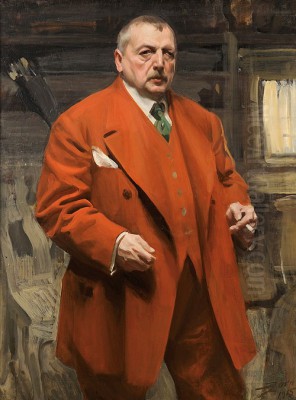
Anders Leonard Zorn stands as one of Sweden's most celebrated artists, a figure whose prodigious talent spanned painting, sculpture, and etching. Born on February 18, 1860, in the small parish of Mora, Dalarna, Sweden, Zorn rose from humble beginnings to achieve international fame. His work, characterized by vibrant energy, technical brilliance, and a profound connection to his native land, continues to captivate audiences worldwide. He was not merely a painter of society portraits or rustic scenes; he was a chronicler of life, light, and the human spirit, leaving an indelible mark on the art world before his death on August 22, 1920.
Early Life and Artistic Awakening
Anders Zorn's origins were modest. Born out of wedlock to Grudd Anna Andersdotter, a seasonal brewery worker from Mora, and Leonhard Zorn, a German master brewer, he spent his formative years raised by his grandparents on their farm in Mora. This rural upbringing in the heart of Dalarna, a region rich in folk culture and natural beauty, deeply influenced his later artistic themes. Initially known simply as Anders, he later incorporated his father's name, Leonard, perhaps seeking a connection to his paternal heritage and potentially enhancing his social standing as his career progressed.
His artistic inclinations surfaced early. Formal schooling began around the age of ten, and by twelve, he was attending secondary school in Enköping. During these years, his innate talent found expression through wood carving and drawing the landscapes and people around him. He displayed a remarkable aptitude for capturing likenesses and the essence of his subjects, whether carving figures of classmates, horses, and local scenes, or sketching the natural world. Some of these early wooden sculptures, testaments to his nascent skill, are preserved today in the Zorn Museum in his hometown of Mora.
Recognizing his potential, Zorn enrolled at the Royal Swedish Academy of Arts in Stockholm in 1875, studying there until 1880. Even as a student, his exceptional abilities set him apart. He quickly gained recognition within the Academy, impressing faculty and peers alike. His time at the Academy provided formal training, honing the skills that would soon launch his professional career.
The Watercolor Virtuoso
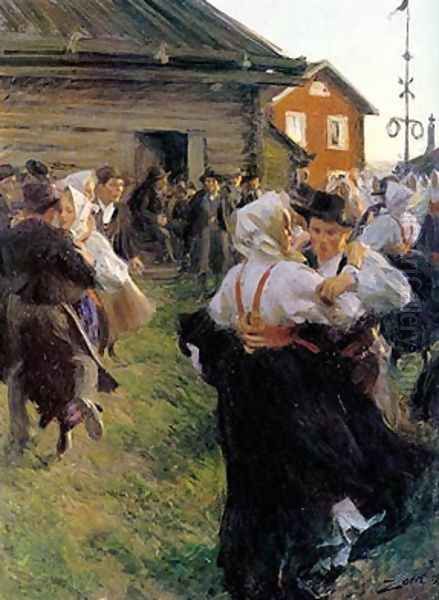
Zorn initially achieved fame through his extraordinary mastery of watercolor. This medium, often considered challenging due to its unforgiving nature, seemed effortless in his hands. His breakthrough came dramatically in 1880, at the age of twenty, during a student exhibition at the Academy. He presented a watercolor titled I sorg (In Mourning). The work depicted a young woman, veiled in black, subtly revealing her grief.
The painting was an immediate sensation. Noted art critic Carl Rupert Nyblom lauded the piece, praising its technical finesse and emotional depth. This single work catapulted the young Zorn into the spotlight, earning him acclaim not just within Sweden but setting the stage for international recognition. His watercolors from this period are characterized by their freshness, luminosity, and seemingly spontaneous yet controlled brushwork. He possessed an uncanny ability to render complex textures, the play of light on surfaces, and subtle human emotions with transparent washes.
Transition to Oil and Impressionist Currents
Despite his success in watercolor, Zorn soon embraced oil painting, the medium for which he would become most widely known. His travels played a crucial role in this transition and in the evolution of his style. After leaving the Academy, he embarked on extensive journeys through Europe, spending significant time in London, Paris, Spain, and Italy. These experiences exposed him to diverse artistic currents, most notably Impressionism.
While Zorn never fully adopted the Impressionist label, its influence is undeniable in his work. He absorbed the Impressionists' fascination with capturing fleeting moments, the effects of natural light, and the use of a brighter palette and looser brushwork. However, he integrated these elements into his own distinct style, one that retained a strong foundation in realistic drawing and a palpable sense of form and volume. His time in Spain, particularly a six-month stay in Seville and Cadiz, proved fruitful, yielding numerous watercolors and attracting commissions from the Spanish aristocracy. Further studies in Italy refined his techniques.
His oil paintings, like his earlier watercolors, often displayed an elegant yet relaxed quality. He applied paint with confidence and bravura, using broad, visible strokes that conveyed energy and immediacy. Whether depicting portraits, scenes of rural Swedish life, or his famous nudes, Zorn demonstrated a remarkable ability to capture the interplay of light and shadow, often using a limited palette to achieve harmonious and powerful effects. He was particularly adept at rendering the texture of skin, the shimmer of water, and the atmosphere of both indoor and outdoor settings.
International Acclaim and Travels
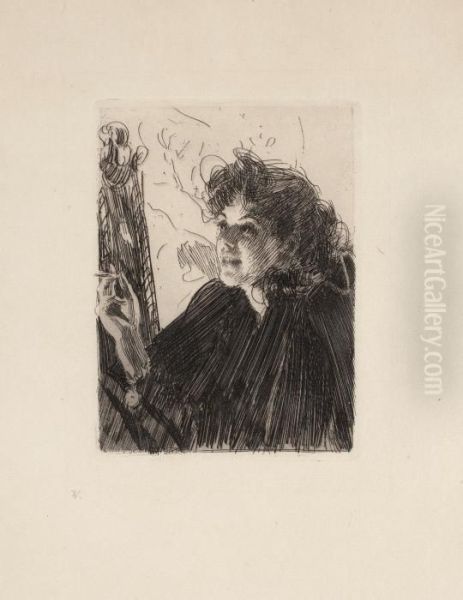
Zorn's talent quickly transcended national borders. His participation in major international exhibitions cemented his reputation. A significant moment was the Paris Exposition Universelle of 1889, where he exhibited an impressive 166 works. The display was met with enthusiastic approval from both the public and the press, and in recognition of his contribution, he was awarded the prestigious French Legion d'Honneur.
His travels were not merely for study but also for commissions and exhibitions. He became a sought-after portraitist among the European and American elite. His journeys took him across the Atlantic multiple times. A pivotal trip occurred in 1893 when he served as the commissioner for the Swedish art exhibition at the World's Columbian Exposition in Chicago. This visit proved instrumental in establishing his presence in the United States.
In Chicago, he met Isabella Stewart Gardner, the prominent Boston art collector and socialite. Gardner became an important patron and friend, commissioning works and helping to introduce him to American high society. Zorn's robust, vital style resonated with American tastes, and he received numerous commissions for portraits during his subsequent visits. His connection to the US art scene deepened over the years, making him one of the most successful European artists working in America at the turn of the century.
The Portraitist of Kings and Presidents
Portraiture formed a significant part of Zorn's oeuvre and was a major source of his international fame and financial success. He possessed a remarkable ability to capture not just the physical likeness of his sitters but also their personality and presence. His portraits are characterized by their vitality, psychological insight, and often unconventional poses or settings. He painted with a directness and confidence that brought his subjects to life.
His sitters included prominent figures from various walks of life – royalty, politicians, industrialists, artists, and society figures. In his native Sweden, he painted King Oscar II. His renown in the United States led to commissions from three American presidents: Grover Cleveland, William Howard Taft, and Theodore Roosevelt. These presidential portraits are notable for their strength and characterization, showcasing Zorn's skill in conveying authority and individuality. His portrait of Isabella Stewart Gardner is another celebrated example, capturing her intelligence and formidable personality.
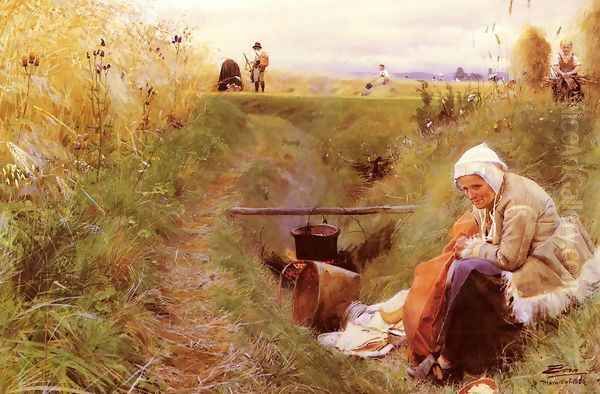
Zorn's approach to portraiture combined his technical virtuosity with an intuitive understanding of human nature. He often employed dramatic lighting and bold brushwork to create dynamic compositions. Unlike the more formal, academic portraits common at the time, Zorn's work felt modern and alive, reflecting the energy of the era. His success in this genre placed him among the leading international portraitists of his day, alongside contemporaries like John Singer Sargent and James McNeill Whistler.
Champion of Swedish Culture and Heritage
Beyond his artistic pursuits, Anders Zorn was deeply committed to preserving and promoting Swedish folk culture, particularly that of his native Dalarna. Having achieved international success and financial security, he and his wife, Emma, became significant cultural philanthropists in their home region. They settled permanently in Mora in 1896, building their iconic home, Zorngården, which itself became a unique blend of traditional Swedish architecture and modern comforts, filled with art and antiques.
Zorn actively worked to safeguard local traditions that were threatened by industrialization and modernization. He began collecting old log buildings from the Mora area, relocating them to create an open-air museum known as Zorn's Gammelgård (Zorn's Old Farm). This initiative helped preserve examples of traditional rural architecture and craftsmanship for future generations.
His passion extended to folk music. Recognizing the decline of traditional Swedish fiddling, Zorn played a key role in its revival. In 1906, he initiated the first Swedish folk music competition in Gesunda, near Mora. This event spurred renewed interest in the genre and led to the establishment of the prestigious Zorn Award (Zornmärket) in 1910, awarded annually to outstanding folk musicians. This award remains the highest honor for folk musicians in Sweden today.
Together, Anders and Emma Zorn founded several community institutions in Mora, including a reading society, a library, a children's home, and the Mora handicraft association (Mora Hemslöjd), which aimed to support local artisans and preserve traditional crafts. These initiatives demonstrate a profound commitment to their community and its cultural heritage, leaving a lasting social legacy alongside Zorn's artistic one.
Master of the Line: Etching
While renowned for his paintings, Zorn was also a master etcher. He approached etching with the same vigor and technical brilliance he brought to painting. He produced around 289 recorded etchings throughout his career, exploring similar subjects: portraits, nudes, genre scenes, and depictions of everyday life. His etchings are highly prized for their spontaneity, bold use of line, and masterful handling of light and shadow.
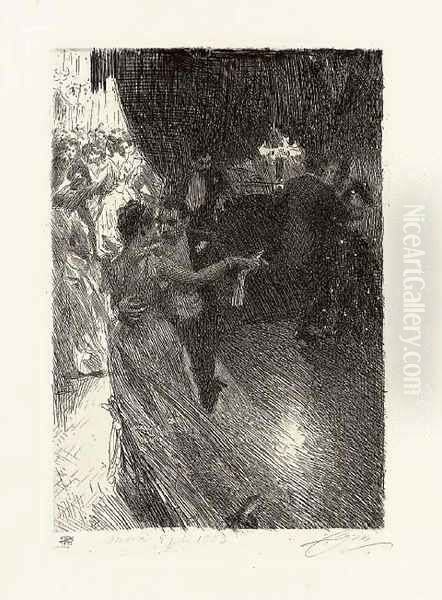
Zorn often worked directly on the copper plate, sometimes from life, capturing a sense of immediacy. He employed a distinctive technique characterized by parallel hatching lines, creating vibrant surfaces and suggesting form and atmosphere with remarkable economy. His ability to render the luminosity of skin, the fluidity of water, or the complexities of a portrait using only black lines on paper was extraordinary.
His etchings achieved international recognition, rivaling his paintings in popularity, particularly in the United States where his prints were eagerly collected. Figures like Rembrandt van Rijn, whose own mastery of etching was legendary, undoubtedly served as an inspiration, but Zorn developed a unique and modern graphic language. His etchings stand as a significant body of work in their own right, showcasing his versatility and his innate understanding of line and tone. Notable etchings include portraits of Auguste Rodin, August Strindberg, and numerous studies of nudes in natural settings.
Sculptural Pursuits
Although less prolific as a sculptor compared to his output in painting and etching, Zorn also worked in three dimensions. His early talent for wood carving foreshadowed this interest. As a mature artist, he created several sculptures, primarily in bronze. These works often depict similar themes found in his paintings, such as figures from Dalarna folklore, nudes, and portraits.
One of his most famous sculptures is the statue of Gustav Vasa (1903) located in Mora, a powerful tribute to the 16th-century Swedish king who played a pivotal role in the nation's history, particularly in Dalarna. Other notable works include fountain figures and smaller statuettes. His sculptures share the same vitality and robust naturalism found in his two-dimensional art, demonstrating his strong sense of form and anatomical understanding across different mediums.
Personal Life: Partnership with Emma Zorn
Anders Zorn's personal life was significantly shaped by his marriage to Emma Lamm (1860–1942). They met in 1881 while Zorn was still establishing his career, and they married in a civil ceremony in Stockholm in the autumn of 1885, following a secret engagement. Emma came from a wealthy and cultured Jewish merchant family in Stockholm. Her background, education, and keen interest in art and culture provided Zorn with valuable support, both personally and professionally.
Emma was more than just the wife of a famous artist; she was an intelligent and capable partner who actively managed Zorn's affairs, organized exhibitions, maintained correspondence, and managed their household and finances. Her organizational skills allowed Zorn the freedom to focus on his art and travels. Their partnership was crucial to his success. They traveled extensively together during the early years of their marriage, living abroad for extended periods before settling in Mora in 1896.
Their home, Zorngården, became a center of cultural life in the region, reflecting both Anders' artistic taste and Emma's management. While Anders was known for his robust, sometimes boisterous personality and enjoyment of life's pleasures, Emma provided a stabilizing influence. The source material mentions a daughter, Kerstin, and their involvement in caring for her children during an illness, suggesting a family life centered around Zorngården. They did not have biological children of their own according to most sources, but they were involved in the lives of relatives and the community, funding scholarships and supporting local children.
Emma Zorn played an instrumental role in preserving her husband's legacy after his death in 1920. She meticulously organized his collections and estate, and in 1939, she opened the Zorn Museum (Zornmuseet) adjacent to their home, fulfilling their shared vision of creating a permanent home for his art and collections in Mora.
Later Life, Legacy, and the Zorn Museum
Anders Zorn enjoyed immense success during his lifetime, achieving both critical acclaim and financial prosperity. He maintained a vigorous pace of work and travel throughout much of his career. His lifestyle was known to be intense; anecdotes suggest he lived life to the fullest, perhaps contributing to a decline in his health in his later years. He suffered from health problems and passed away in Mora on August 22, 1920, at the age of 60.
His legacy, however, was secure. He left behind a vast body of work across multiple mediums, celebrated for its technical skill, vitality, and unique blend of traditional representation and modern sensibilities. His depictions of Swedish life and landscapes helped shape the image of Sweden both domestically and internationally. His influence extended beyond his own art through his efforts to preserve folk culture and support his community.
Today, Anders Zorn is regarded as one of the giants of Swedish art. His works are held in major museums around the world, including the Nationalmuseum in Stockholm, the Metropolitan Museum of Art in New York, the Musée d'Orsay in Paris, and the Museum of Fine Arts in Boston. The Zorn Museum in Mora, established by Emma Zorn, remains the most important center for the study and appreciation of his work, housing a large collection of his paintings, sculptures, etchings, and watercolors, as well as Zorngården itself and the open-air museum Gammelgården.
Zorn in Context: Contemporaries and Influence
Anders Zorn emerged during a dynamic period in European art. He navigated the transition from 19th-century Realism to the various currents of Modernism. While influenced by Impressionism, particularly the work of artists like Claude Monet, Pierre-Auguste Renoir, and Edgar Degas in their handling of light and everyday subjects, Zorn forged his own path. His robust realism and bravura brushwork set him apart from the more purely optical concerns of French Impressionism.
As a portraitist, he operated in an international arena alongside figures like John Singer Sargent, whose dazzling technique and society portraits offer points of comparison, and James McNeill Whistler, known for his tonal harmonies and aestheticism. Zorn's portraits, however, often possess a raw energy and psychological directness that feels distinctly Nordic.
Within Scandinavia, Zorn was a leading figure, contemporary with artists like the Danish Skagen Painters Peder Severin Krøyer and Michael Ancher, who also explored light and everyday life, and fellow Swede Carl Larsson, whose idyllic domestic scenes contrast with Zorn's more vigorous style. He also worked during the era of Edvard Munch, though Zorn's art generally lacked the intense psychological angst characteristic of the Norwegian Symbolist. His connection to Spanish art, perhaps influenced by masters like Diego Velázquez, can be seen in his tonal control and confident brushwork, and he was contemporary with the Spanish luminist Joaquín Sorolla, who shared Zorn's fascination with light and outdoor scenes. His mastery of etching inevitably invites comparison with Rembrandt, while his nudes sometimes echo the sensuousness found in works by artists like Renoir or even earlier masters. His international success, particularly in America, was remarkable, with his etchings at one point being more sought after than Rembrandt's among certain collectors.
Academic Perspectives and Enduring Relevance
Academic interest in Anders Zorn remains strong. Scholars continue to study various facets of his career: his technical innovations in watercolor, oil, and etching; his role as a leading international portraitist; his complex relationship with Impressionism and Modernism; and his significant contributions to Swedish cultural preservation. Exhibitions frequently explore specific aspects of his work, such as his process from sketch to finished piece, his depictions of water and light, or his life in Paris and America.
Research highlights his unique position bridging traditional craftsmanship with a modern, energetic vision. His commitment to his native Dalarna and its folk traditions is recognized as a vital part of his identity and legacy, offering a counterpoint to his cosmopolitan career. Studies delve into his patronage networks, particularly his relationship with Isabella Stewart Gardner and other American collectors, revealing the dynamics of the transatlantic art market at the turn of the century.
The market value of Zorn's work remains high, reflecting continued appreciation from collectors and institutions. His paintings and etchings regularly appear at auction, often commanding significant prices. This enduring appeal underscores his status not just as a historical figure, but as an artist whose technical brilliance and vibrant depictions of life continue to resonate.
Conclusion
Anders Zorn was a force of nature in the art world. From his roots in rural Sweden, he rose to become an artist of international stature, celebrated for his dazzling technique, his mastery of light, and his ability to capture the vitality of his subjects. Whether painting portraits of presidents, depicting scenes of Swedish peasant life, rendering luminous nudes by the water's edge, or capturing character through the incisive lines of an etching, Zorn's work exudes energy and confidence. His legacy encompasses not only his artistic output but also his profound dedication to preserving the cultural heritage of his homeland. A master craftsman, a keen observer of humanity, and a vital link between tradition and modernity, Anders Zorn remains a compelling and important figure in the history of art.